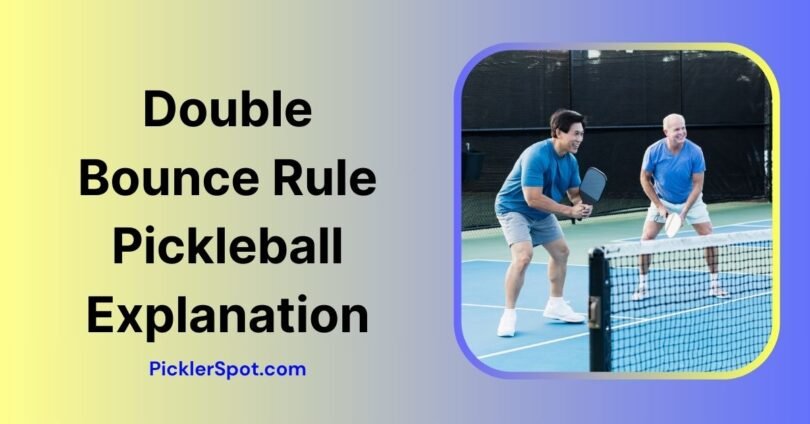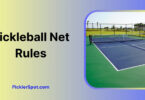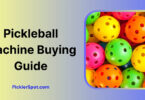The dilemma about Pickleball is that even though it’s a game that has straightforward rules and strategies, it baffles some individuals especially when it comes to implementing the regulations and rules that affect the strategy of the sport.
The double bounce rule, amongst many other rules, seems to be pondering both newbies and experienced players as the rookies fail to understand how and where it should be implemented while the advanced players struggle to grasp the ideology behind it.
But to flush the ambiguity, I have taken upon the duty to curate a comprehensive article that corresponds to the double bounce rule pickleball explanation all while keeping it as simple to interpret as possible.
Let’s start with the preliminaries,
Double Bounce Rule Pickleball Explanation
- In Pickleball, once a serve happens by the server, the receiving team must allow the ball to bounce once before swinging at the ball so that it returns back to the original server.
- Once the ball makes its way back to the server, the server has to then allow the ball to bounce once before returning it to the other end of the court.
- Once the ball hits the ground and bounces on each end, each side can initiate the volley execution and start a rally as long as they are standing against the kitchen zone.
- Keep in mind that if by any chance, intentionally or unintentionally any side of the team fails to adhere to the double bounce rule and hits the ball before it reaches the ground, it will result in a fault.
What is The Point Of the Double Bounce Rule?
As confusing as this rule might sound, there are plenty of reasons why this rule is implemented in Pickleball, here is why,
Balancing Factor
These specific rules ensure both sides remain in the same state without the factor of gaining unnecessary advantage at the start of the game. Once a ball is served, each side has to ensure they execute a groundstroke. Without this rule, the receiver would hit the ball once it is served right across the net, giving them an unfair advantage.
This also ensures the game commences towards a proper rally system, so each player in each team can position themselves without feeling out of place.
In other words, each player gets a fair chance to utilize their strategies without feeling ambushed by the other.
Introduces Variation
Pickleball is more than just flinging or swinging the paddle in any direction you see fit, there are tons of executions such as Dink, Lob, Ernie, drop shot, and poaching. Moreover, you are also required to execute top spins and back spins to keep the game much more interesting all while covering every side of the court.
The double bounce rule ensures these strategies are implemented and players adhere to a specific rule all while maintaining a level playing field. Variation of techniques also ensures proper skills are developed for each player as other forms of shot execution are introduced.
Nullfies Toxicity
The essence of pickleball is to display signs of sportsmanship and stick by the rules without exploiting another opponent. While you may win a couple of matches through trickery and deceit in the longer run you will eventually ruin the essence of the game which is frowned upon by the Pickleball community.
The double bounce rule offers much more than just a rule that ensures players stick to groundstroke-based strategies and in fact allows them to lessen toxicity by preventing unnecessary domination by each player regardless of skill set.
In other words, you are supposed to win games through proper techniques and methodologies, and rallying on tricks may not be one of them.
Is There An Exception For Double Bounce Rule In Pickleball?
Yes, individuals who have mobility limited and are playing in wheelchairs are allowed to let the ball bounce more than two times as they have hurdles covering the court.
This rule is automatically implemented if the game is played by players who are facing disability and have a hard time moving around the court. In that case, the double bounce rule capacity is incremented up to an additional bounce, which means it can bounce up to three times in general before it is hit with a groundstroke.
Can A Ball Bounce More Than Once On Each Side?
No, as long as both the players on each team are fully abled with no mobility restrictions, they are required to hit the ball once it lands and bounces on their side of the court. If by any means it lands on a non volley zone and then bounces again, it will result in a “double bounce fault”, and you might lose a point.
The ball also has to bounce inside the court, if it makes its way outside the court, it will result in a fault since it is counted as an “out-of-boundary fault”.
Additional Tips To Keep In Mind
Here are some tips that will help you prepare better if the double bounce rules feel too overwhelming.
- Always work on your agility and use plenty of footwork when hitting groundstrokes, being stationary will leave you vulnerable to deeper shots.
- Once you perform a return shot, always move back to baseline, in that way you will have a bigger field of view as compared to the net area where snappier shots will baffle you, leaving less time to react.
- Sometimes, in Pickleball, things can get confusing, so if your opponent calls for a double bounce fault, accept it because it’s better to reply with a point than argue.
- Avoid rushing when you have hit your groundstroke as your opponent can easily outmaneuver you with a spin.
- Whenever you are stacking, make sure you call out for a volley, so your teammate can cover your back, otherwise, it will create confusion and you may lose a point due to lack of communication.
Bottom Line
Rather than avoiding learning a technique or abiding by rules, always embrace it so you can develop new skills and polish the ones that you have already attained.
Pickleball is all about having fun and having the best possible experience, so learning these nuances could help the game be much more enjoyable and keep toxicity to the bare minimum as it introduces a sense of fair play.









